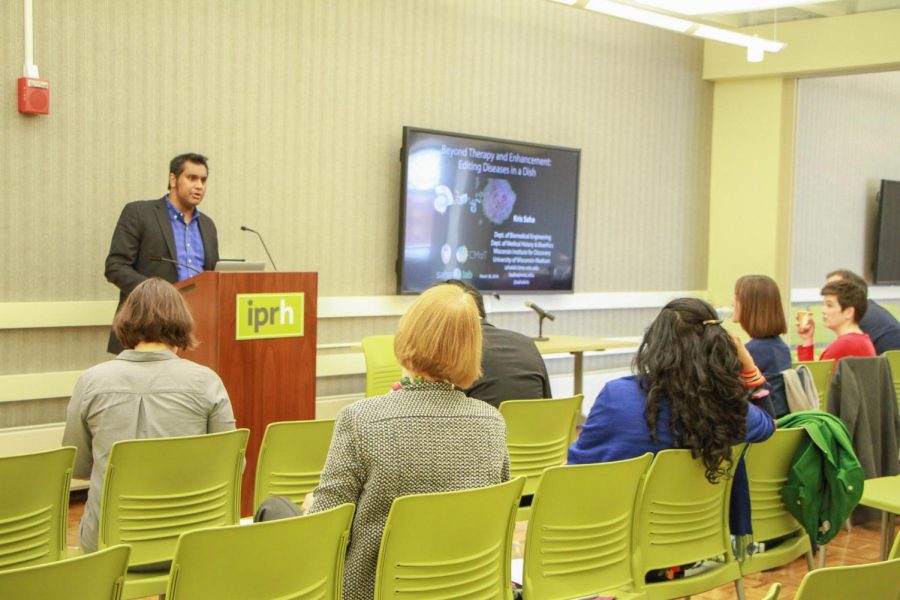Campus focuses on interdisciplinary approach to research
The Illinois Program for Research in the Humanities hosted the Bio-Humanities Symposium on March 30. Kris Saha from the University of Wisconsin-Madison gave a talk on “Editing Diseases in a Dish.”
Apr 2, 2018
Last updated on April 16, 2018 at 04:12 p.m.
At the Krannert Center a few years ago, physics professor Smitha Vishveshwara met Latrelle Bright, an active faculty member in the theater department. Despite their different concentrations of study, they were introduced due to a common ground.
Vishveshwara studies theoretical condensed matter physics. Both of her parents were physicists. She is a member of the Beckman Institute, and she also teaches PHYS 498: Where Art Meets Physics.
In this class, she teaches a number of physics concepts, including the quantum world, the cosmos and flow.
After learning about these topics, the students use their creativity to craft multimedia art pieces. The pieces can be massive, incorporating physics terms and equations from the quantum level to the cosmos.
Get The Daily Illini in your inbox!
Vishveshwara said the artistry “allows you to perceive the science that you’re studying in new ways.”
This interdisciplinary approach to education and research appears throughout campus, especially concerning the crossover of STEM subjects with the humanities.
Recently, Vishveshwara took this concept of interdisciplinary studies to the extreme and created Quantum Voyages alongside Bright. This performance sends two voyagers guided by “the spirit of knowledge” to explore the surrounding world at an atomic and quantum level.
Several of Vishveshwara’s students are acting, composing original music, painting and designing costumes for the show. She calls it a Renaissance way of studying.
Across campus, the Illinois Program for Research in the Humanities is taking its own steps to make science and the humanities meet.
Nancy Castro is the deputy director of the IPRH. Her job is to support the research of humanists on campus.
“It’s important to honor the expertise our humanities faculty can bring to a problem that might otherwise be addressed differently by a scientist or a technologist,” Castro said.
This past year, the IPRH hosted several programs and events that bring about what Castro calls the “cross-pollination” of STEM and the humanities.
After two years of planning, they created Speculative Futures, which the poster describes as the “intersection of science, technology sci-fi imagination.” This event brought artists, writers and innovators of technology together to discuss how the two broad fields collide.
In March, they hosted Marvelous Fabrications. Here, art and design professor Ben Grosser and mechanical science and engineering professor Amy LaViers demonstrated their robots’ abilities. Elly R. Truitt, a history expert, then provided a response to their demonstrations. The three then had a panel to discuss robots and their histories.
One of their largest enterprises in interdisciplinary research is Emerging Areas in the Humanities, a program sponsored by a grant from the Andrew W. Mellon Fellowship Program.
In the course of six years, from 2016 to 2022, three different interdisciplinary, inter-generational research groups are formed consecutively. The first, headed by Samantha Frost, political science professor, studied bio-humanities. The next focus, beginning in fall 2018, is environmental humanities and will be led by Robert Morrissey, associate professor of history.
Morrissey just finished selecting the post-doctoral fellows, graduate fellows and undergraduate interns. Their fields of study vary from anthropology, to the history of science, to urban and regional planning.
“There are questions that are complicated enough,” he said. “The insights of one discipline can’t possibly exhaust the subject or get us to the solutions that we need.”
As a part of this research group, these eight individuals will initiate and build upon the interdisciplinary conversations held on campus concerning the environment. They will each have their individual research projects, bring speakers to campus and be involved with the development of the curriculum.
Overall, the agenda of this group is to define what environmental humanities are on this campus and bring together interested parties.
“We, as humanists, have a specific set of critical lenses that we can lend to those conversations that can be really valuable,” Morrissey said.
Morrissey also said without these perspectives, something important in these conversations would be missing.
Leslie Reagan agrees with Morrissey.
For several years, Reagan taught at the medical college on campus although she is not a doctor and has never received a medical degree. Reagan is a history professor and taught the history of medicine.
In her class, students learn how medicine and perceptions of health evolve over time. She said society’s response to illness is a cultural response.
Reagan says medicine, history and a number of other subjects cannot be taught in separate ways. She says it’s important to learn about how these subjects react to one another. In Reagan’s opinion, it’s good for students and scholars to have a broad spectrum of knowledge.
“I think it improves the work that can be produced, the research and the experience of anyone who then is getting the benefit of any science or medicine that’s offered, to actually know how it affects society and how it affects people,” Reagan said.
The way that the humanities and sciences are perceived is also considered.
Reagan pointed out the University’s website.
“There’s very little on that website that tells students they should be taking humanities courses,” Reagan said.
Reagan said the website tells students every day about test tubes, technology and science, and instead, it should help students become more well-rounded.
When Vishveshwara considered this imbalance, she said “to address the challenges, you really need the whole spectrum — everything from ethics to the science behind it to beautiful visualization by artists.”






